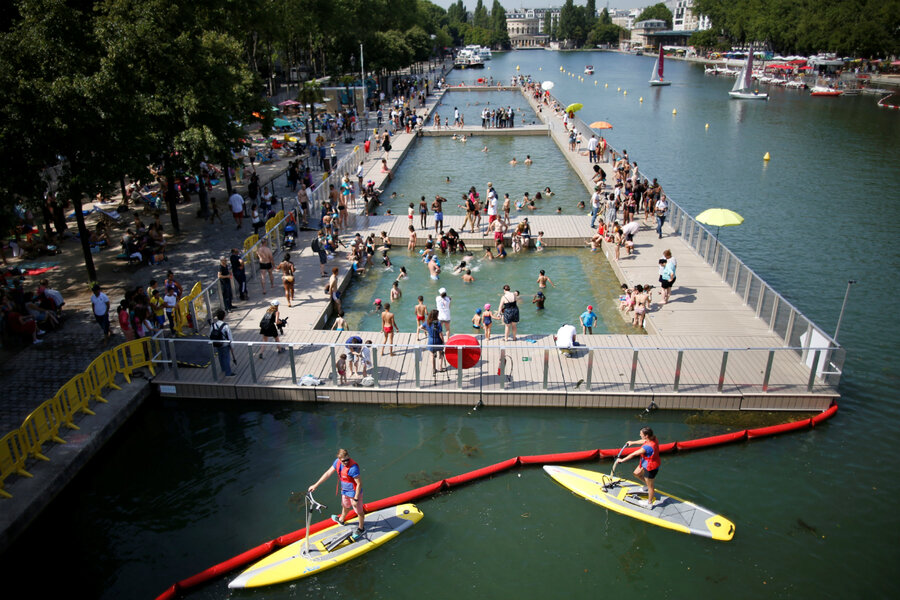Global river cleanups grow
Loading...
One-tenth of an inch. That’s the amount of rain the underground pipe system in Portland, Ore., used to be able to accommodate before sewage overflowed into the nearby Willamette River. The heavy rains characteristic of the Pacific Northwest resulted in 50 to 100 sludge dumps per year into the Willamette, water quality warnings to city residents, and a resigned sense that the Willamette was unfit for swimming.
But more than 2,500 Portlandians could be seen happily plunging into the Willamette this summer as part of Human Access Project’s seventh annual “Big Float.” A new $1.4 billion pipe system, as well as HAP’s seven-year effort to change perceptions, has renewed recreational interest in the river.
A worldwide battle is under way to revive riverways in urban areas where they had been largely valued as channels for getting rid of sewage and industrial waste. The iceberglike chunks floating down India’s Yamuna River, for example, are really solidified chemical waste dumped by upstream factories. And the Buriganga River in neighboring Bangladesh looks “slick and shiny” because of chemicals from the $1 billion tanning industry, says Reuters.
But perceptions about a river’s purpose are beginning to shift. From Portland to Paris, Los Angeles to London, cities around the world are cleaning up their waterways, bringing a sense of rejuvenation to spaces once known more for trash and sewage leaks than as natural sites.
“That move to start restoring rivers and protecting the rights of rivers is something that actually we’re seeing all over the world,” says Sarah Bardeen, the communications director of International Rivers, a nonprofit committed to promoting healthy river projects in Berkeley, Calif.
In the United States, the cleanup of polluted waterways has been incremental. But experts point to the signing of the 1972 Clean Water Act, which safeguarded water quality and changed how Americans relate to local bodies of water, as pivotal. In 2015, the Clean Water Rule, which extended federal protection to small streams and rivers, delivered more incentive for cleanups.
In Los Angeles, the city spent the past 20 years creating an expansive greenway along the Los Angeles River. As a result, locals can now meander along 20.2 miles of new bike paths and parks and access key recreation zones for fishing and kayaking.
Baltimore has recently added two trash-eating waterwheels – invented by a local who was tired of the pollution – and man-made, pollution-sucking islands to its inner harbor. But the city has a ways to go. Baltimore’s own Healthy Harbor Initiative has given the harbor failing water quality grades since 2013.
Other examples of river cleanups are popping up across the globe. Such grass-roots involvement is also taking place on the banks of the Spree in Berlin; the Yarra River in Melbourne, Australia; and the Thames in London. “What we see now is ... more ... communities [taking] back and [restoring] their rivers, [to] create those healthy environments where they want to live, thrive, and recreate,” says Jason Carey, principal engineer at River Restoration, a Colorado-based river stewardship organization.
Paris recently enticed locals into the water when it unveiled three floating, filtered pools in the Bassin de la Villette, thereby legalizing swimming – an activity that had been banned for almost a century in the city. Prior to the opening, officials spent $10 million over four months last year to drain the canal, remove trash, and relocate fish to the Seine.
The investment paid off, as Parisians have been passing the summer enthusiastically paddling in the new enclosures. One citizen told Télérama.fr that her first swim was “a joy.” In 2019, the city plans to make swimming possible in Lake Daumesnil, and may open up the Seine to paddlers, if the city wins the bid to host the 2024 Olympic Games, reports France’s The Local.
In the US, water ecosystem improvements and dam removals used to occur mainly in rural areas and were generally carried out by federal agencies. But more-recent efforts are built around community.
“Ultimately, it’s about people... In order for any project to be successful, you’ve got to bring the people together,” says Amy Kober, senior communication director of American Rivers.







